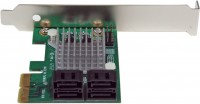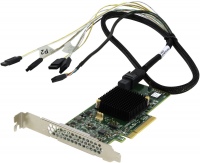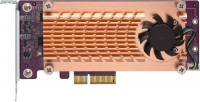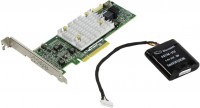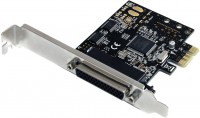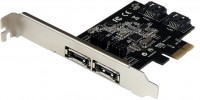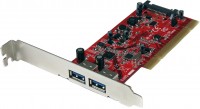PCI Controller Cards Startech.com
All models Advanced filters → |
You might be interested in
PCI Controller Cards: specifications, types
Show all
Product type
— Expansion board. Controllers of this type are actually adapters designed to equip the computer with additional connectors. Thus, you can both increase the total number of existing connectors (for example, USB), and equip the system with an interface that was not originally in it — for example, add an outdated LPT port to a modern computer. Accordingly, such controllers necessarily have certain external connectors.
— RAID.... Controllers designed to connect additional drives to the system — both internal and external (depending on the specific model). In accordance with the name, they have the ability to create RAID disk arrays. Such an array combines several disks, thereby increasing the speed and/or reliability of operation (depending on the specific connection format, see “RAID levels” for more details). Such equipment can be especially useful if the motherboard does not have a built-in RAID controller, or if one is already enabled. However, we note that when using such a controller, it is not necessary to create a RAID array — you can work with each disk separately.
— RAID.... Controllers designed to connect additional drives to the system — both internal and external (depending on the specific model). In accordance with the name, they have the ability to create RAID disk arrays. Such an array combines several disks, thereby increasing the speed and/or reliability of operation (depending on the specific connection format, see “RAID levels” for more details). Such equipment can be especially useful if the motherboard does not have a built-in RAID controller, or if one is already enabled. However, we note that when using such a controller, it is not necessary to create a RAID array — you can work with each disk separately.
Interface
An interface that connects a PCI controller to a motherboard.
— PCI-E (PCI Express). An interface that is actually a modern standard for motherboards and peripherals connected to them, including PCI controllers. It is the heir to PCI-E, noticeably surpasses it both in terms of data transfer speed and additional functionality. Note that "motherboards" and peripherals for them can use a different number of PCI-E lines — for controllers, in particular, options 1x, 2x, 4x and 8x are relevant. At the same time, the first three values are found among expansion cards, but 8 PCI-E lanes are used mainly in RAID controllers (see "Type"). Also note that more lines means not only higher speed, but also a larger connector size. As a result, a board with a smaller number of lines can be connected to a slot with numerous channels (for example, a 1x board in a 4x connector), but not vice versa. As for bandwidth, it depends on the PCI-E version and is slightly less than 1 GB / s per line for PCI-E 3.0 and slightly less than 2 GB / s per line for PCI-E 4.0.
— PCI. Due to the advent of the more advanced PCI-E standard, this interface is now considered obsolete. However, it provides data transfer rates up to 533 Mbps, which is quite enough for tasks that do not involve the need to quickly transfer large amounts of information. Another advantage is that when connected to such a connector, faster PCI-E slots remain free, which can be useful for other system components. As a result, PCI connectors are still used in modern motherboards, and controllers with such a connection can also be found on the market.
— PCI-E (PCI Express). An interface that is actually a modern standard for motherboards and peripherals connected to them, including PCI controllers. It is the heir to PCI-E, noticeably surpasses it both in terms of data transfer speed and additional functionality. Note that "motherboards" and peripherals for them can use a different number of PCI-E lines — for controllers, in particular, options 1x, 2x, 4x and 8x are relevant. At the same time, the first three values are found among expansion cards, but 8 PCI-E lanes are used mainly in RAID controllers (see "Type"). Also note that more lines means not only higher speed, but also a larger connector size. As a result, a board with a smaller number of lines can be connected to a slot with numerous channels (for example, a 1x board in a 4x connector), but not vice versa. As for bandwidth, it depends on the PCI-E version and is slightly less than 1 GB / s per line for PCI-E 3.0 and slightly less than 2 GB / s per line for PCI-E 4.0.
— PCI. Due to the advent of the more advanced PCI-E standard, this interface is now considered obsolete. However, it provides data transfer rates up to 533 Mbps, which is quite enough for tasks that do not involve the need to quickly transfer large amounts of information. Another advantage is that when connected to such a connector, faster PCI-E slots remain free, which can be useful for other system components. As a result, PCI connectors are still used in modern motherboards, and controllers with such a connection can also be found on the market.
RAID levels
RAID levels supported by the respective controller (see "Type").
The RAID level determines how disks are combined into an array and how they work together. Specific options might be:
— 0. Disk array without redundancy and duplication. The information stored in such an array is divided into fragments of a fixed length, which are written to each of the disks in turn. The advantage of RAID 0 arrays is the increased speed of access to...large volumes of data: the speed of work increases as many times as many disks are combined into an array. On the other hand, such a combination reduces reliability: if one of their disks fails, the entire volume of data becomes inaccessible.
— 1. Mirrored disk array: Written data is copied to each individual disk. In other words, each individual drive in such an array is an exact copy of another drive. This provides the highest degree of fault tolerance: the information remains available in full volume as long as at least one disk is working in the array. At the same time, the read speed is quite acceptable, and when using query parallelization, it is even higher than when using a single drive. The main disadvantage of RAID 1 is very high redundancy: the working capacity of the array is equal to the capacity of only one disk.
— 0+1. A RAID 1 array composed of RAID 0 arrays. See above for more on both; and their combination allows you to combine the advantages and to some extent compensate for the disadvantages of both options: the array turns out to be fast and at the same time resistant to failures of individual disks. However, in terms of fault tolerance, this combination is still inferior to RAID 10 (see below), and therefore is used somewhat less frequently.
— 1E. A specific combination of RAID 0 and RAID 1. It consists of at least 3 disks, in which each piece of information is copied simultaneously to two disks, and these disks are interleaved: for example, the first fragment is copied to the first and second disks, the second — to the second and third, the third — to the third and first, etc. This format of operation gives higher performance than RAID 1, while the array's performance is maintained when one drive fails.
— 5. A recording format that involves the use of the so-called checksums — service data used for error correction. A RAID 5 array must include at least three drives. And information is written to them as follows: data fragments are written to all disks, except for one, and the checksum of these fragments is written to the remaining disk. At the same time, the disks on which the checksum is written change every time: for example, in an array of 4 disks, the first three fragments are written to the first, second and third disk, their checksum to the fourth, the second three fragments to the second, third and fourth with a checksum on the first one, etc. The meaning of the checksum is that it can be used to restore the lost data fragment if necessary. Thus, RAID 5 arrays have good fault tolerance with relatively low redundancy: the total array size is equal to the sum of the capacities of all disks minus the capacity of one disk, and when one of the drives fails, lost data is restored using checksums. On the other hand, the performance of such arrays is lower than individual drives due to additional operations for calculating checksums. And when two or more drives fail, the entire array becomes unavailable.
— 6. Recording format similar to RAID 5 described above, but with two checksums written to two separate drives. This improves resiliency—the array remains available if any two drives fail—but reduces performance even further. A RAID 6 array requires at least 4 drives, and the total capacity is equal to the sum of the capacity of all drives minus the capacity of the two drives.
— 10. A RAID 0 array composed of RAID 1 arrays. See above for more information on these formats; and such a combination to a certain extent unites their advantages and mutually compensates for their shortcomings. Thus, RAID 10 provides high read speed and at the same time is completely insensitive to single disk failure. In fact, half of the drives in such an array, or even more, can fail, and the array will remain operational if at least one working disk remains in each individual RAID 1 block. The main disadvantage of this format is the same as in RAID 1 — high redundancy.
— 50. A RAID 0 array made up of RAID 5 arrays. See the respective sections for details on both. This combination allows you to significantly increase the speed of operation compared to "pure" RAID 5, while it provides good fault tolerance: the array remains operational even if several disks fail, provided that these disks are in different RAID 5 blocks (one per block). block). The disadvantage of RAID 50 is that it requires at least 6 disks (2 minimum RAID 5 arrays).
— 60. A RAID 0 array composed of RAID 6 arrays. In general, it is similar to the RAID 50 described above, but it has, on the one hand, higher fault tolerance, and on the other hand, more redundancy. So, the array remains operational when two disks fail in each RAID 6 block, and the total volume of RAID 60 is calculated by the formula V * (n-2s), where V is the volume of one disk, n is the total number of disks, s is the number of blocks RAID 6.
— JBOD. The simplest format for combining several disks into one logical drive. Information in the JBOD is written to the first disk, when the space on it runs out — to the second, and so on. JBOD allows you to combine disks with different sizes and speeds, it fully uses the capacity of all disks, and it is also more fault-tolerant than RAID 0, which is similar in many respects: if one of the disks fails, only information on this disk is lost in JBOD, the rest of the data remains available.
— Hybrid RAID. A format for combining disks that involves a combination of RAID of one level or another (the specific level may be different in different models, this point should be specified separately) with an SSD solid-state module. The latter plays the role of an intermediate cache, increasing the speed of reading and writing. The use of Hybrid RAID is justified when working with relatively small amounts of data on a regular basis — for example, in file server or virtual machine mode.
— Hyper Duos. Another hybrid storage technology that combines hard drives and solid state modules. Allows you to add up to three SSDs to one HDD. According to the creators, the optimized algorithms make it possible to provide almost the same data exchange speed as when using a full-fledged SSD module, while such a hybrid drive costs much less than a solid-state drive of the same volume. In addition, the Hyper Duo controller allows you to select the operating mode: "Capacity" (capacity), in which the capacity of the array is the sum of the capacities of all drives, or "Safe" (security), in which information from a smaller storage medium (SSD) is constantly duplicated on more capacitive (HDD).
The RAID level determines how disks are combined into an array and how they work together. Specific options might be:
— 0. Disk array without redundancy and duplication. The information stored in such an array is divided into fragments of a fixed length, which are written to each of the disks in turn. The advantage of RAID 0 arrays is the increased speed of access to...large volumes of data: the speed of work increases as many times as many disks are combined into an array. On the other hand, such a combination reduces reliability: if one of their disks fails, the entire volume of data becomes inaccessible.
— 1. Mirrored disk array: Written data is copied to each individual disk. In other words, each individual drive in such an array is an exact copy of another drive. This provides the highest degree of fault tolerance: the information remains available in full volume as long as at least one disk is working in the array. At the same time, the read speed is quite acceptable, and when using query parallelization, it is even higher than when using a single drive. The main disadvantage of RAID 1 is very high redundancy: the working capacity of the array is equal to the capacity of only one disk.
— 0+1. A RAID 1 array composed of RAID 0 arrays. See above for more on both; and their combination allows you to combine the advantages and to some extent compensate for the disadvantages of both options: the array turns out to be fast and at the same time resistant to failures of individual disks. However, in terms of fault tolerance, this combination is still inferior to RAID 10 (see below), and therefore is used somewhat less frequently.
— 1E. A specific combination of RAID 0 and RAID 1. It consists of at least 3 disks, in which each piece of information is copied simultaneously to two disks, and these disks are interleaved: for example, the first fragment is copied to the first and second disks, the second — to the second and third, the third — to the third and first, etc. This format of operation gives higher performance than RAID 1, while the array's performance is maintained when one drive fails.
— 5. A recording format that involves the use of the so-called checksums — service data used for error correction. A RAID 5 array must include at least three drives. And information is written to them as follows: data fragments are written to all disks, except for one, and the checksum of these fragments is written to the remaining disk. At the same time, the disks on which the checksum is written change every time: for example, in an array of 4 disks, the first three fragments are written to the first, second and third disk, their checksum to the fourth, the second three fragments to the second, third and fourth with a checksum on the first one, etc. The meaning of the checksum is that it can be used to restore the lost data fragment if necessary. Thus, RAID 5 arrays have good fault tolerance with relatively low redundancy: the total array size is equal to the sum of the capacities of all disks minus the capacity of one disk, and when one of the drives fails, lost data is restored using checksums. On the other hand, the performance of such arrays is lower than individual drives due to additional operations for calculating checksums. And when two or more drives fail, the entire array becomes unavailable.
— 6. Recording format similar to RAID 5 described above, but with two checksums written to two separate drives. This improves resiliency—the array remains available if any two drives fail—but reduces performance even further. A RAID 6 array requires at least 4 drives, and the total capacity is equal to the sum of the capacity of all drives minus the capacity of the two drives.
— 10. A RAID 0 array composed of RAID 1 arrays. See above for more information on these formats; and such a combination to a certain extent unites their advantages and mutually compensates for their shortcomings. Thus, RAID 10 provides high read speed and at the same time is completely insensitive to single disk failure. In fact, half of the drives in such an array, or even more, can fail, and the array will remain operational if at least one working disk remains in each individual RAID 1 block. The main disadvantage of this format is the same as in RAID 1 — high redundancy.
— 50. A RAID 0 array made up of RAID 5 arrays. See the respective sections for details on both. This combination allows you to significantly increase the speed of operation compared to "pure" RAID 5, while it provides good fault tolerance: the array remains operational even if several disks fail, provided that these disks are in different RAID 5 blocks (one per block). block). The disadvantage of RAID 50 is that it requires at least 6 disks (2 minimum RAID 5 arrays).
— 60. A RAID 0 array composed of RAID 6 arrays. In general, it is similar to the RAID 50 described above, but it has, on the one hand, higher fault tolerance, and on the other hand, more redundancy. So, the array remains operational when two disks fail in each RAID 6 block, and the total volume of RAID 60 is calculated by the formula V * (n-2s), where V is the volume of one disk, n is the total number of disks, s is the number of blocks RAID 6.
— JBOD. The simplest format for combining several disks into one logical drive. Information in the JBOD is written to the first disk, when the space on it runs out — to the second, and so on. JBOD allows you to combine disks with different sizes and speeds, it fully uses the capacity of all disks, and it is also more fault-tolerant than RAID 0, which is similar in many respects: if one of the disks fails, only information on this disk is lost in JBOD, the rest of the data remains available.
— Hybrid RAID. A format for combining disks that involves a combination of RAID of one level or another (the specific level may be different in different models, this point should be specified separately) with an SSD solid-state module. The latter plays the role of an intermediate cache, increasing the speed of reading and writing. The use of Hybrid RAID is justified when working with relatively small amounts of data on a regular basis — for example, in file server or virtual machine mode.
— Hyper Duos. Another hybrid storage technology that combines hard drives and solid state modules. Allows you to add up to three SSDs to one HDD. According to the creators, the optimized algorithms make it possible to provide almost the same data exchange speed as when using a full-fledged SSD module, while such a hybrid drive costs much less than a solid-state drive of the same volume. In addition, the Hyper Duo controller allows you to select the operating mode: "Capacity" (capacity), in which the capacity of the array is the sum of the capacities of all drives, or "Safe" (security), in which information from a smaller storage medium (SSD) is constantly duplicated on more capacitive (HDD).
PS/2
Number of PS/2 ports provided in the design.
PS/2 is a specialized port designed to connect exclusively to keyboards and/or mice. The presence of PS/2 can relieve the user of the need to occupy USB ports for the keyboard/mouse; this is especially useful if you have a lot of other USB peripherals to deal with. On the other hand, for a number of reasons this connector is considered obsolete and is used less and less; and PS/2 peripherals are produced mainly in the form of USB devices, ad...ditionally equipped with PS/2 adapters.
PS/2 is a specialized port designed to connect exclusively to keyboards and/or mice. The presence of PS/2 can relieve the user of the need to occupy USB ports for the keyboard/mouse; this is especially useful if you have a lot of other USB peripherals to deal with. On the other hand, for a number of reasons this connector is considered obsolete and is used less and less; and PS/2 peripherals are produced mainly in the form of USB devices, ad...ditionally equipped with PS/2 adapters.
USB 2.0
The number of USB 2.0 connectors on the external panel of the controller.
USB (all versions) is the most popular modern interface for connecting external peripherals. Specifically, the USB 2.0 standard is now considered obsolete: for example, the data transfer rate with such a connection does not exceed 480 Mbps, and the power supply is very low. And although such capabilities are quite sufficient at least for undemanding peripherals like keyboards,...mice, etc., however, PCI controllers with this type of connector are becoming less common — manufacturers generally prefer more advanced interfaces, such as USB 3.2 gen1 and gen2 ( see below).
USB (all versions) is the most popular modern interface for connecting external peripherals. Specifically, the USB 2.0 standard is now considered obsolete: for example, the data transfer rate with such a connection does not exceed 480 Mbps, and the power supply is very low. And although such capabilities are quite sufficient at least for undemanding peripherals like keyboards,...mice, etc., however, PCI controllers with this type of connector are becoming less common — manufacturers generally prefer more advanced interfaces, such as USB 3.2 gen1 and gen2 ( see below).
USB 3.2 gen1
The number of USB 3.2 gen1 connectors on the external panel of the controller.
USB (all versions) is the most popular modern interface for connecting external peripherals. USB 3.2 gen1 (formerly known as USB 3.1 gen1 and USB 3.0) is the successor to the popular USB 2.0 standard, introducing 10x faster data transfer rates (up to 4.8Gbps) as well as more power for peripherals. Some connectors may even provide support for USB Power Delivery technology,...which allows you to deliver power up to 100 W per connector (although Power Delivery is not strictly required, it is better to specify it separately). Anyway, the USB 3.2 gen1 interface is extremely popular in modern computers and peripherals.
Separately, it is worth noting that the connection in the USB 3.2 gen1 format can also be carried out via USB-C connectors. However, such connectors are specified separately in the characteristics of PCI controllers (see below), in this case, classic, full-size USB sockets are meant (the so-called USB A ).
USB (all versions) is the most popular modern interface for connecting external peripherals. USB 3.2 gen1 (formerly known as USB 3.1 gen1 and USB 3.0) is the successor to the popular USB 2.0 standard, introducing 10x faster data transfer rates (up to 4.8Gbps) as well as more power for peripherals. Some connectors may even provide support for USB Power Delivery technology,...which allows you to deliver power up to 100 W per connector (although Power Delivery is not strictly required, it is better to specify it separately). Anyway, the USB 3.2 gen1 interface is extremely popular in modern computers and peripherals.
Separately, it is worth noting that the connection in the USB 3.2 gen1 format can also be carried out via USB-C connectors. However, such connectors are specified separately in the characteristics of PCI controllers (see below), in this case, classic, full-size USB sockets are meant (the so-called USB A ).


